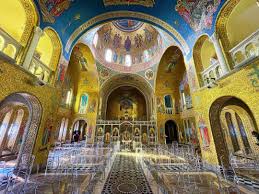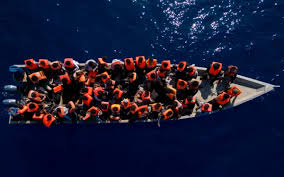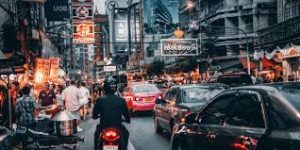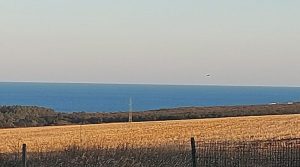Italy: Volcanoes, witches, and wild beauty – inside secret isle of Panarea
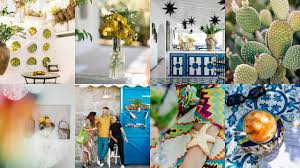
Stephanie Rafanelli
Rome: “I travelled the globe looking for a home. Then I came to Panarea and found one – with the whole world within it.” This scrawl, attributed to one “Mastro Ciccio, 1920”, is chalked in dialect on the entrance to his Aeolian island home. It is a beautiful door, faded and peeling, but still singing to me as I pass by barefoot. And it’s the same cyan as the waves that skirt this tiny car-free island in the Tyrrhenian, moving like a boundless sea of torn silk. Even residents are transfixed by the stretch of water that lies between Panarea – a 1.3-square-mile chunk of volcanic rock – and Stromboli, the island 13.5 nautical miles to the northeast with an active volcano that has erupted almost continuously since 350 BC. When talking, the Panarioti always keep one eye out there. Right now, in the deceptive gold of dawn, Stromboli is as peaceful as a pyramid on the horizon, its red-hot summit just some trick of the light.
Stromboli is nicknamed “Iddu”, a dialect word for “Him”, as a sign of respect for its mysticism and power. Iddu is a shape-shifter encircled by eight shadowy islets. The eastern side of Panarea is the world’s best viewing deck to observe “his” histrionics, in an amphitheatre of isolotti whose appearance transforms depending on the sun’s position. Panarea is the smallest and oldest of the seven inhabited Aeolian islands scattered like dice up to 56 miles from Sicily’s northeastern coast, the result of fiery submarine volcanoes. Above water they open into jagged obsidian fields and sulphur mines. Their Malvasia grapes and salted capers are infused with gun-smoke minerality, as if they lie on a brink between heaven and hell, scented by honeysuckle and an aroma like burnt matches.
Savage in terrain but fertile in the Italian imagination, this remote archipelago of subsistence farmers and fisherwomen was still living in the 19th century when it was discovered in the 1950s by the neorealist filmmakers whose lenses documented its timeless insularity in the fast modernising economic miracle that was Italy. Roberto Rossellini shot Stromboli, Land of God with Hollywood’s Ingrid Bergman in 1950. In the same year, William Dieterle filmed Volcano, starring Rossellini’s muse, Anna Magnani. And Blow-Up director Michelangelo Antonioni tortured his leading lady, Monica Vitti – known as “the Queen of Italian Cinema”– on Panarea’s islets in the bankrupt, blighted production of L’Avventura in 1960.
Everything and everyone here are not just closely related, but tightly roped together.
With its basalt skerries and pumice cliffs, it feels as though Panarea was born in black and white, in spite of its ubiquitous indigo doors. Everywhere, the shadows of prickly pears loom on the whitewashed steps of Grecian-esque sugar cube houses. Cats with white necks and inky blotches scurry in the heat along low terracotta roofs in the harbour town of San Pietro, which cowers beneath the 1,381-foot-high summit of Punta del Corvo, the highest point on the island. Seagulls preen themselves as fastidiously as felines. Everything and everyone here are not just closely related, but tightly roped together. The 300 inhabitants are, after all, in the same figurative boat, with Stromboli acting as lighthouse, sundial and compass. Panarea is so quiet that the island’s police force is made up of three carabinieri, who patrol the narrow whitewashed alleys in golf carts, with not much to keep under control but the riots of bougainvillea crawling over their charming station. People mainly travel by foot here, and it takes 16 minutes to walk from the boutiques of San Pietro, interspersed with lemon groves, to Zimmari Beach, with its brown-sugar-like sand.
Unlike Capri, Panarea still functions as an island community, despite having hidden away some starry outsiders for more than 70 years. The island has a way of absorbing the famous, who must adapt to its uncompromising character, not the other way around. There are no five-star hotels, big brands or marina. “People who come here find nothing – and everything,” says Pietro Catania, an impish nonagenarian with forget-me-not-blue eyes, at San Pietro’s social epicentre, Bar del Porto. The son of the bar’s founder, he is a regular fixture, always immaculately dressed as if ready for actress Monica Vitti to return. Catania’s own sons, Rosario and Franco, now run the show here, their chef turning out butter-soft octopus salads and prawn spaghetti perfumed by cantaloupe-y Malvasia wine and a squeeze of lemon. We sit together as I sketch their family tree on a napkin that heats like warm bread in the sun. These cane chairs have been angled towards Iddu since 1960, before which terracettes of olives and wheat, now fallow, stretched down to the waves. “I travelled the globe looking for a home…” I too feel I have found one. Within days I’m on first-name terms with everyone on the seafront strip, and ready to conduct the rest of my life with the soles of my feet blackened.
Fiercely-protective of their microcosm, the Panarioti are hostile to unnecessary progress: after all, they were happy with candlelight until electricity came in the early ’80s. When the authorities tried to replace the moon with street lamps, the islanders overruled them. It was unthinkable to murder the romance of walking home guided by swaying mast-top lights like -shooting stars. Until about the 1950s, on Panarea – like on Alicudi, the most westerly Aeolian isle – women-fearing locals still believed in the legend of Le Donne Volanti, or Flying Women. Fisher-witches, they reported, took to the skies in their skiffs at night, rowing past the -crescent moon. Such visions were later attributed to the consumption of the hallucinogenic ergot fungus.
Among the first well-known outsiders to drop anchor was Chilean surrealist painter Roberto Matta, a contemporary of Salvador Dalí, who disembarked from the triweekly ferry in 1954 with an emergency crate of Champagne. “We were poor farmers and fishermen, we’d never met rich people before, so we treated them like everyone else,” says Catania. From the late 1960s the bohemian Milanese set followed, shedding suits, skinny dipping and letting their hair grow as long as the bearded palms. They slummed it at two-star hotel Raya, which has grown organically in size, stature and status over the years. The elite club has lured the summer super-flotsam of the Mediterranean – from late Fiat chairman Gianni Agnelli to Aristotle Onassis – to its dance floor, which, in the moonlight, seems to extend, pale and glittering, to the horizon. Raya’s louche reputation has always overshadowed the real Panarea. “But we are not the Italian Ibiza,” insists manager Anna Calì. “Raya holds parties two weeks a year in August. The rest of the time we live quietly.”
Raya’s owners – Paolo Tilche, a self-taught architect and charismatic rake, and the late fashion designer Myriam Beltrami – caused a stir when they first arrived. “She always walked around in a transparent dress with no bra,” chuckles Catania, clapping his hands. “Sometimes no dress at all. She would sunbathe naked on the rocks. There were a few hundred court cases about it.” After coming to Panarea from Milan in the ’60s, these legends of the 1970s – who also shared a house in Bali – built Raya. The minimalist temple to Euro-bohemianism ascends the mountainside above San Pietro like a helter-skelter wedding cake made on magic mushrooms. Rooms with wobbly walls and white floors remain -purposefully no-frills. Raya was always about the club (a kind of precursor to the elite Raya dating app) and its view of the tilted islet of Basiluzzo reclining like a Buddha before the ever-smouldering Stromboli.
Tilche built more homes on Panarea in his primitive-modernist style, for returning soul-searchers. On the wild, fennel-strewn road to the hamlet of Drauto, newly restored villa Antika is a trio of wisteria and bougainvillea draped buildings with five bedrooms between them. It was designed by Tilche in the early 1970s, inspired by Pantelleria’s stone dammusi houses, and has porthole windows and wild capers sprigging from its sea walls. Monochromatic interiors nod to the monasticism of Raya, with walls of marmorino (a putty used by the Romans to give the effect of polished marble) that subtly shift hue with the day, from stone, clay and almond to alabaster. Colour accents are strictly limited to shades of olive and the coppery blue-green cacti in the suitably undone gardens. Antika’s real living rooms are its columned verandas, where faces and legs are striped with the shadows of cane shades. Beyond the mackerel skin of the water are the hazy outlines of the mainland city of Reggio Calabria and Sicily’s Mount Etna. Antika’s main hedonistic indulgence is eating outdoors. Venezuelan private chef Jehnny Juul, who has lived on Panarea for 18 years, prepares exquisite plates: nectar-like grilled peaches and burrata; petal salad with the purple crowns of caper flowers; and spaghetti allo frescaiolo with sweet bombs of datterini tomatoes. Juul cooks with ingredients from her permaculture allotments at Punta Milazzese, a nature reserve on the southern tip of Panarea and pit stop for migrating Eleonora’s falcons.
Descendants of giuseppe cincotta, a well-loved island doctor and namesake of the seafront, run some of San Pietro’s white, tiled hotels. His daughter, octogenarian Lidia, is the high priestess of the hotel La Piazza, and her niece Angela now runs Hotel Lisca Bianca, and she has an encyclopedic memory of island events (“I remember when Bob Marley came to Raya – the club was like Eyes Wide Shut.”).
Angela’s son, the gentle Antonio, is the designer and curator of the island’s undone style – his Buganville boutiques hang with silks so light they barely kiss limbs. Turmeric, mint and orange granita is the frozen elixir of choice at Bar Da Carola, run by the Tesoriero clan, and Anna Mandarano of Supermercato Da Anna is the unofficial island consigliere, whose son – the sensitive Ruggero, a roll-up-smoking Buddhist fisherman – delivers arancini in a golf cart straight from her kitchen to the villa gardens. Dinners are at Da Pina. Founded in the 1960s by restaurateur Pina Cincotta Mandarano, it was a favourite of Agnelli and is still frequented by the superyacht crowd. Its cult gnocchi di melanzana recipe is kept alive by Cincotta Mandarano’s maximalist daughter, Giovanna Mandarano. All power prints and “Stromboli pink” lipstick, she appeared as an extra in L’Avventura at the age of six. “My mother was an absolute volcano,” she tells me. “Things are run by women here. Panarea has always been a matriarchy. The men were away working in the mines or abroad, or fighting world wars. So the women fished and rowed their catches 70 kilometres to the market in mainland Milazzo.”
“People think Panarea is all about the sea,” Juul tells me as she takes me hiking one morning. “No one talks about the nature [on land] here. We need to reconnect to it.” The sun is still dripping its yolk on the skyline as we start our steep ascent of Punta del Corvo on ancient shepherds’ paths; her dog, Alfie, races ahead and drives a parting in the broom. At sea level, Panarea is rimmed with whites and blues. Up here it is as green and purple as Scotland, with evergreen myrtle and streaks of heather. It takes three hours to loop the island, and when we finally reach a plateau, there is no sound but the humming of a bumblebee. A cloud creeping slowly over us gives me a giddy sensation of movement. But below, the sea is as flat as an ice rink, scratched with the skate marks of tacking yachts. A detailed chart of the Aeolian islands is laid out around us. To the east are Lipari and Vulcano; to the west, Filicudi, with its stingray’s tail, then the vongole shell of Alicudi. Standing before such a vista is the “everything” that comes with “nothing” here. The view is as unchanged as the lost art of walking mapless by moonlight.
I imagine what it would have been like to scale this summit at a time when even getting from Milan to Panarea was an intrepid trek. In the 1960s, Agnelli sailed here on his teak-decked 82-foot yawl, Agneta. Antika has its own version, Tortuga, a 72-foot ketch built in 1963. Later that morning we explore Panarea’s volcanic isolotti on Antika’s other vessel, Dorotea, a Riva-style wooden-hulled speedboat made on Panarea by artisanal shipwright Andrea Tesoriero. At the helm is Toni Mellus. Stocky, tanned and salty as a seafaring prosciutto, he has captained boats since 1986.
By now the morning is almost blindingly bright. The surface of the water looks as viscous as jelly as we wave to Ruggero, a roll-up in his mouth as he hauls in coral-like scorpion fish. We power to the rocky islet Basiluzzo, which emerges from the waves like the tilted monument of some lost civilisation, with the nearby Spinazzola rock resembling the stone throne of its kingdom. Cultivated and inhabited during the Roman era – the mosaic floor of a villa remains – Basiluzzo is now reigned by windswept dwarf palms and breaking waves. The fractured rock of Lisca Bianca, which translates as “white fishbone”, is the savage domain of seabirds, and owes its name as much to the constant -bombardment of guano as to its pumice stone beaches. I’m reminded of 1960 and L’Avventura: after the production went temporarily bankrupt, the crew were stranded in this prehistoric place for three days.
From here we snorkel to Bottaro island, beneath which sulphurous bubbles break as if a restless creature were lurking underwater. And beyond is the island of Dattilo, which, at sunset, will look like a church ablaze. At dusk we return to the water and trail northeast to see Stromboli’s neon rope of lava, most visible after dark. The water is as silver and heavy as mercury. Suddenly the unremarkable sight of a fishing boat, patrolled by seagulls, appears like a mirage, sailing on its own reflection. Under the clear evening sky, with the thunder of Stromboli’s eruptions rolling, the vision is strangely biblical.
The Thinking Traveller offers stays at Antika from £11,995 per week, including a transfer from the port, daily cleaning, sole use of the villa and grounds, and a dedicated local team to assist with everything from logistics to planning experiences; thethinkingtraveller.com

